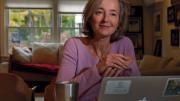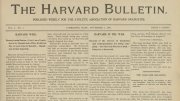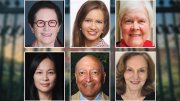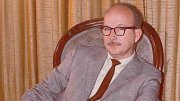At first, Blyth Lord, Ed.M. ’94, took every opportunity to tell her own story. It felt right, and healing, to honor the life of her daughter Cameron, who had died of a rare genetic disease at two years old. In 2013, when Lord began developing a nonprofit for caregivers of severely ill children, she found that revealing her own hurt, and showing that surviving such a loss was possible, was profoundly helpful to other grieving parents.
Nine years later, the Courageous Parents Network (CPN) is on the forefront of educating and supporting caregivers and clinicians, and the lens on Cameron’s death has shifted. “I would just as soon never mention my story,” says Lord. “I recognize myself in these other parents, and I want to reassure them that this huge hole that you feel will no longer just be a dark, black, sad hole. It doesn’t go away, but how you live with it and how you touch it will stop being so painful and, in fact, maybe will give you strength.”
This devotion to transforming pain underscores all that Lord does. Cameron died of infantile Tay-Sachs disease, a disorder that attacks nerve cells in the brain and spinal cord; barring medical interventions that temporarily prolong life, the disease is always fatal, usually by age three.
Without help from family and friends and a host of professionals, Lord says, her family would not have endured that wrenching two-year period from diagnosis to hospitalizations, and through the decision not to treat Cameron’s last pneumonia. Their palliative-minded pediatrician Richard Goldstein, M.D. ’89, especially, provided guidance in making the hardest decisions. “God bless him. He was willing to hear us,” she says, “and it was only about comfort at the end.”
Palliative medicine is specialized care aimed at relieving physical symptoms, like nausea and pain, and other difficulties, like insomnia and depression, associated with serious illness. It is non-curative, complementary support, unrelated to prognosis, and designed instead to improve quality of life for patients and their families and help coordinate communication and decision-making. Unlike hospice care, which addresses end-of-life needs, palliative medicine is ideally available at any stage of illness. For children, Lord says, such care means “helping them have their best lives for as long as possible. And if it’s framed that way, what parent would say no to that?”
The world of pediatric medical crises—of days and nights spent in intensive care units, of tending to children 24/7 in the home—is most often hidden from those beyond a close circle. Pediatric palliative care is, mildly put, emotionally charged. “First, it is difficult for any human being, understandably, to accept that they or someone they love has a life-limiting condition. The ultimate finality of it is so brutal,” she says. But layer onto that the “unnaturalness” of the loss of a child, and the idea is just anathema. There’s also a belief in the “miracles” of modern medicine in the United States. “We have so many ways to keep these children alive,” Lord says, and that can lead to an “initial assumption that there must be a way to treat or cure my child. A sense of ‘Can’t we fix this?’”
CPN’s power derives from capturing these complex and intimate challenges through more than 600 videos, podcasts, and downloadable guides—all free to caregivers and clinicians at courageousparentsnetwork.org. Included are recordings of monthly Zoom gatherings called “In the Room”: open-ended discussions with parent and clinician speakers, led by Lord and other CPN team members, covering topics like enduring the holidays, what to tell siblings, how to hold a marriage together, finding palliative care, and what it’s really like to operate a “mini-ICU” for children at home. The nonprofit, with a $870,000 annual budget and nine full- and part-time staffers, including a pediatric psychologist, relies primarily on individual donations. More than 2,500 parents and 2,200 clinicians have joined the free network, although thousands more use the online materials.
What makes Lord’s work more of a calling is the ability to look squarely into the void of these unfathomable experiences and come out on the other side—not unscathed, but renewed. “We have to face that children get sick and some of them are not going to get better,” she says, simply. “In that, two things run concurrently: hope and grief. You work in the hope space, and you tend to the grief.”
The depth and breadth of CPN’s primary resources and educational outreach are unparalleled within the rare pediatric disease and care community. “What Blyth has done is taken the parent voice and been able to compound it with many parent voices and tell these stories writ large,” says Amy Melnick, executive director of the National Coalition for Hospice and Palliative Care. “What is also unique about CPN is that it is able to make the bridge to clinicians.”
The digital resources can serve as teaching and training tools for practitioners who are often ill-prepared to face grief-stricken parents in crises. While recently presenting CPN’s mission and resources to a clinical team at New York City’s Weill Cornell Medicine, Lord responded to a pediatrician who expressed discomfort addressing or labeling a family’s experience as “anticipatory grief” (sadness about an impending loss) for fear of offending them. “By acknowledging their grief,” she explained, “you are validating their feelings that this is hard, and this is not the life they wanted for their child.”
At a delicate juncture, Lord believes, it is a medical professional’s role to be “compassionate, honest, and specific.” This approach was highlighted during her recent CPN video interview with Ashley and Theron Tingstad, of Michigan. When their newborn son Viggo was diagnosed last year with the rare chromosomal disorder Trisomy 5p, the medical staff initially tiptoed around them. Talking about “goals of care,” they offered vague reasons for hope, Theron tells Lord, but “without telling us what we were going to need it for.” Treatments like surgery, gastric feeding tubes, and tracheal intubation can address symptoms but are not cures.
When they were speed-reading medical texts about their son’s condition and cradling him in the neonatal intensive care unit (NICU), Ashley explains, finally, “One doctor did say to me, ‘You’re living every mother’s nightmare.’” Was it helpful or not? Lord asks. “When I told people about it, they were horrified that a doctor would say that,” says Ashley. “But [the doctor] was a mother, too, and she had tears in her eyes, and she was genuine. So, I actually found it helpful because for a moment she was acknowledging our experience and not just dissecting my baby.”
During the last two decades, Lord, who lives outside Boston, has sought out hundreds of such conversations, presented medical and other training programs, participated in hospital roundtables and seminars, and spoken at conferences nationwide.
“There are no right or wrong decisions about interventions...only what’s right for their own child and family.”
As a board member of the National Tay-Sachs and Allied Diseases Association, she introduced pediatric palliative care (PPC) and the notion of “finding your own philosophy of care.” “There are no right or wrong decisions about interventions, like feeding tubes,” she says,“only what’s right for their own child and family.” When the grief was still fresh, she and her husband, Charles P. Lord—along with his brother and wife, whose son died of infantile Tay-Sachs two months before Cameron—formed the Lord Foundation to fund PPC research and programming. Using skills honed during a 20-year career in television production, Blyth Lord also co-created Cameron’s Arc: Creating a Full Life. The video, with a teaching guide, chronicled the Lords’ relationship with Richard Goldstein, associate professor of pediatrics, who has since become director of the program on sudden unexpected death at Boston Children’s Hospital.
Lord is the only parent member of the executive committee of the American Academy of Pediatrics’ Section on Hospice and Palliative Medicine. In 2021, she was awarded the Presidential Citation for Palliative Care Advocacy from the American Academy of Hospice and Palliative Medicine, and last year she and CPN’s director of community engagement Jennifer Siedman (another longtime advocate, who lost her son in 2015 to Sanfilippo syndrome) received the TORCH Award for rare disease patient advocacy from Sanofi U.S.
Synthesizing information and shaping educational messages is not new to Lord. She majored in history at Yale (where she also met her husband). Impressed by Walter Cronkite’s handling of the CBS Evening News, she pursued television journalism. But working in network news in New York City and Washington, D.C., proved “too cutthroat,” she says, “and I was not ambitious enough to sacrifice my life for the story, which I felt you kind of had to do.” Children’s television seemed more aligned with her values. At the Graduate School of Education in 1993-94, she focused on learning and technology, earning the credentials to switch fields. By 2004, she’d landed at Boston’s public television station, WGBH, and worked as a coordinating producer of children’s programming until she left to start CPN and advocate more intensely for pediatric palliative care.
A relatively new field, PPC faces emotional, business, and medical barriers. Although many major American children’s hospitals have dedicated teams to the practice, that is a recent development, and prognostic uncertainty can make clinicians reluctant to raise the topic or refer a case, Lord says. The Affordable Care Act enables families to pursue medical treatment and hospice care concurrently (instead of one or the other, as adults must do), but this option is not always fully explained, and access to palliative-informed care for ill children varies enormously. Money is a factor, too: compared to medical procedures, Lord says, palliative care conversations are not big “revenue-generators for hospitals.”
Parents in a medical crisis can feel “a bit like kryptonite,” says Ashley Tingstad. “I think it’s that it’s just too sad” for other people to cope with. Days in the NICU after Viggo’s diagnosis turned into months of learning, often from NICU nurses, about how children with his condition live—how long, under what limitations—and how they die. Faced with his complications after one surgery, the couple approved what turned out to be a grueling re-intubation. Witnessing that led to long conversations and their resolution not to allow it again. Three months later, Viggo went into total respiratory distress at the hospital and died at the age of six months.
That decision has not lessened their sadness. “But that we could give him a peaceful death, knowing that he was loved, and he was comfortable and safe with us holding him,” Tingstad says, brings comfort and lessens the pain of what would have been “a traumatic medical death.” Turning down interventions means taking on “the responsibility for that, and you have to live with, on your hard days, the ‘What if?’” she explains. “Whether you intervene or not, you’re always making a decision. You’re playing God, and nobody wants to play God.” In the end, she and Theron felt that “if we as parents are trying to center our children’s experience every day with every choice, I don’t see how we can go wrong.”
That tenet also led the Lords not to treat their daughter’s last pneumonia more than two decades ago. During the interview, Lord tells the younger couple how much they remind her of all she and Charles went through then: the soul-searching, the slew of professional consultations, the hopeful search for new information—all stops on the road toward preparing for what parents are never really prepared for.
“It’s a very brave thing to let your child die, to privilege your child’s peace over your own pain,” Lord tells them. “In my experience, you’re already tasting the strength of the decision you made. And I promise that that conviction will serve you very well and get stronger with the passage of time. That ‘What if?’ will go away. It really will go away. Eventually.”









